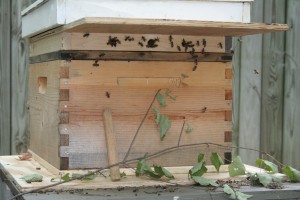New Bottom Board / Top Entrance
Wednesday, September 8th, 2010The hive has been infested with hive beetles for as long as I can remember and this summer the infestation has grown. I’ve been puzzling over this for some time to see whether there was anything I could do. I tried SHB traps with oil with little success. The beetles hide mostly in the cracks at the corners of the hive and at the end of the frames. They also hide in the corners of the inner cover and before I removed them, under the metal strips (rails) supporting the frames.
The old bottom board that I was using had a huge gap between the boards with plenty of SHBs hiding in there. When I took it off, there were bees underneath, so it appears that the crack was wide enough for bees to walk in and out of the bottom. The bees were trying to gum it up with propolis.
I have the idea that I’d like to build a better hive to eliminate SHB friendly crevices, but that’s going to take more thinking.
While thinking about the SHB problem, I read the Bush Bees pages on top bar hives and on top entrances. I decided to go to a top entrance and to replace the bottom board with a cleaner, tighter bottom board.
OK, so I didn’ t plan it quite that well.
The first step was to build a new bottom board. I used a 2′ x 2′ plywood board with 1″ x 3″ strapping flat around the sides with 45 degree joints. Noah and the girls helped and it came out nicely. There was no place that I could see that a small hive beetle could hide. We installed the new board and noticed all the SHBs on the old board with all the bees underneath.
This is when phase 2 of the plan became more obvious. I hadn’t planned for any entrance at all. The solution was to invert the old bottom board and put it on top of the hive with the old cover on top. The next day, we got another bit of plywood (conveniently sitting in the garage waiting) and mounted more 1″ x 3″ strapping, but this time perpendicularly. We then drilled three holes in the front board and mounted it on the top of the hive. The board was longer than a hive allowing for a overhang above the entrance. It strikes me that this is much more like the hive that was in my house a few years back.
Here’s the result:
I put the branch and the wood strip there so that the bees would reorient. I don’t know whether it did any good, but I don’t think it did any harm.
From bottom to top here’s how it stacks up:
- bottom board
- brood box (standard 10 frame deep)
- inner cover
- top cover (with three entrance holes)
- old cover (not essential)
By the way, I didn’t spot the queen in the last inspection so I took a look again during this operation. She was on the outside of frame 4. Phew!
New worries:
- Will the hive overheat?
- Is there formaldehyde in the new bottom board which might bother the bees?
- Are three holes enough for the bees? They previously had a big front gap and an unknown gap under the hive.
New hopes:
- The hive will triumph over SHB finally.
- The hive will have better climate control with fewer gaps
- The hive will have fewer pests with fewer entrances.
- Fewer bees will have to spend time gluing things shut with propolis.
- The hive will grow strong and winter over well.
Time will tell.
Saint Ambrose, patron of bees and beekeepers, pray for us.
